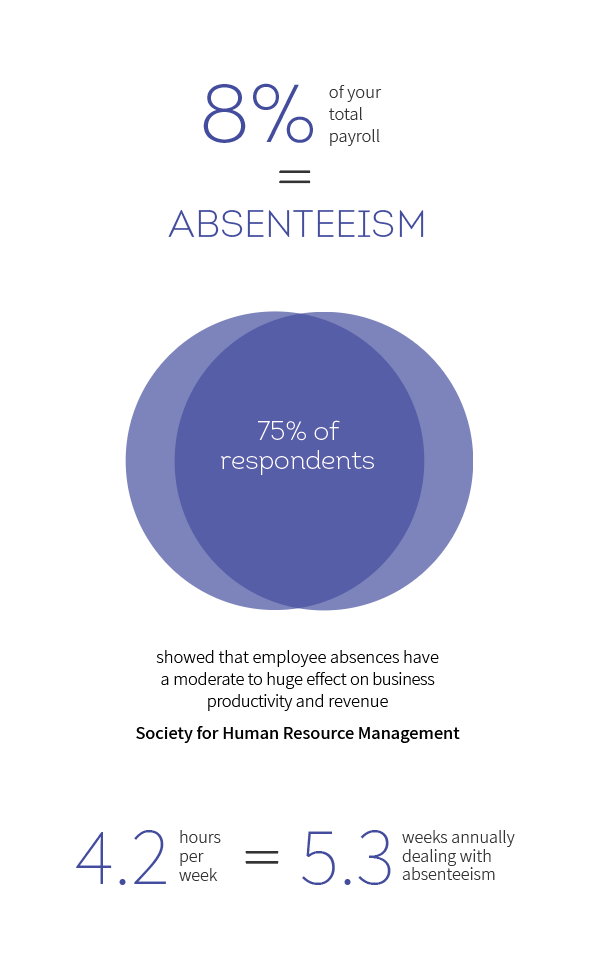The ultimate guide to absence management

Prioritising absence management
For any business, talent is the most valuable asset - but also their greatest cost. This is especially true for absenteeism, as it is estimated this costs Australian businesses directly in excess of $35 billion a year*.

Absenteeism affects all industries, and as of 2017 the average Australian employee is absent for 9.7 days a year.
What does this mean for individual businesses?
It’s estimated that 8% of your total payroll costs is down to managing the fallout from absenteeism. It’s important to note this isn’t just direct costs, managers spend on average 4.2 hours per week or about 5.3 weeks annually dealing with issues arising from absenteeism including getting replacements, adjusting work process and giving training. It is clear having a formal strategy


Measuring absenteeism
The first element to any approach to managing absenteeism is measurement. This can be done holistically at a company scale for a given period.
Total hours / days of absence / total working hours * 100
This percentage is a good top level metric to track workplace absence, but doesn’t allow you to draw any insights. Is this made up of fewer long term of more short terms absences? Is this skewed by a particular individual or group?
For more directionality and to help manage disturbance based from absenteeism, companies can use the Bradford Index. This should be implemented by the line manager and is based on the premise that multiple short term absences are more disruptive than longer term absences.
S2 X D = Bradford Index
This is where S is the number of absences and D is the number of total days absent. For instance if an employee is absent 3 times in a given year for 10 days in total, the Bradford Index would be 3 X 3 X 10 = 90.
This number is just a number though, it is up to the organisation to set triggers. For instance a policy could outline that any score above 100 requires further assessment of why this employee is taking multiple days off.
It is important to note that the Bradford Index assumes 28 days of holiday a year and should only be used as part of a complete investigation into absence. Research suggests that when used as the only measure or where triggers are set too low, the Bradford Index is not successful at reducing absenteeism.
In addition there has been debate in the UK around the use of the Bradford Index with the Disabilities Discrimination Act as certain disabilities may lead to a higher likelihood of ongoing absence.
Understanding root causes
Measuring absenteeism is essential, as Peter Drucker said
“If you can’t measure it you can’t improve it.”
But it’s only the start of reducing or mitigating the impact to your business. Every situation is unique but generally, the reasons for absence can be grouped into five main categories.
Illness and caring for the ill
Management practices
Employee disengagement
simple now through technology such as Culture Amp. In larger
In
Work related stress
symptom of a wider problem.
Culture of sick leave entitlement
their work colleagues who have to take up the strain or absences will help employees makes it more relatable. Also having a clear policy on absenteeism that is communicated to all new starters so no bad habits creep in.
Our partnerships make temporary staffing simple

Developing a formal policy
A formal attendance policy that is clear and effectively communicated is essential to ensure employees know what is expected of them. Each company will have different requirements but some of the areas that may be included are:
- Standard working hours
- Paid holidays
- Carer’s and compassionate leave
- Flexible/remote working
- Paid sick days
- Eligibility requirements
- Notification of absence
- Requirements for medical certification
- Measurement of attendance
- Disciplinary
actions - Counselling
- Recognition of attendance
When implementing a formal policy it is critical that this is
enforced
Strategies to manage absenteeism
Creating and sharing a formal policy is the best way to manage absenteeism - alongside wellness and employee engagement strategies this build an empowered and productive workforce. But as was mentioned earlier, a culture of presenteeism is just as bad and so how can business stay productive when an employee is genuinely ill.

Weploy is an on-demand staffing platform that can help HR leaders and hiring managers scope with short term and ongoing absenteeism no matter the reason.
We connect you with pre-qualified Contact Centre and business support talent that can come to your office at late notice. There is no dealing with recruiters, no hidden costs and quality is guaranteed. Simply log on to Weploy and post your job with a description of the tasks needed to be carried out. Jobs are accepted on average in under 30 seconds and workers turn up in a couple of hours.
We take the stress from finding suitable replacements, helping your teams stay productive and engaged and allowing you to focus on what matters to your business.